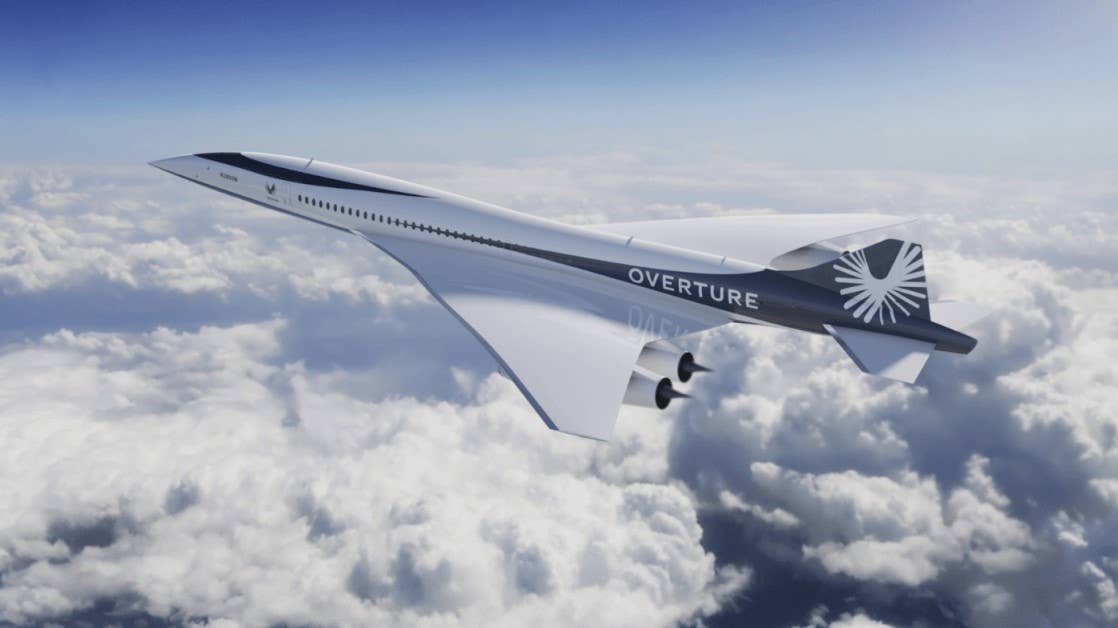Boom Unveils Supersonic Overture Flight Deck
The developer of a supersonic passenger airliner provides a few key updates at the Farnborough International Airshow.

Boom Supersonic’s Overture is intended to carry 64-80 passengers at twice the speed of subsonic airliners. [Courtesy: Boom Supersonic]
Boom Supersonic, the developer of a supersonic passenger airline that has attracted the interest of United Airlines and American Airlines, on Tuesday gave a pair of key updates on its flagship Overture aircraft and Symphony engine.
At the Farnborough International Airshow in the U.K., Boom unveiled Overture’s flight deck, built around technology from partner Honeywell, and predicted it will have a full-scale engine core operational by 2025. The company also announced Tuesday it secured a Symphony assembly and testing facility through an expansion of its existing partnership with StandardAero.
Boom aims to fly Overture in 2026 ahead of a planned 2029 commercial rollout with airlines worldwide. A supersonic demonstrator aircraft, the XB-1, completed its maiden voyage in March.
Overture’s state-of-the-art flight deck runs on Honeywell’s Anthem avionics suite, which is also the system of choice for electric vertical takeoff and landing (eVTOL) aircraft manufacturers Lilium and Vertical Aerospace.
According to Boom, it will be the first airliner to feature force-feedback sidesticks, which give pilots a physical response to the aircraft’s movement as well as inputs made by the copilot or autopilot.
Like something out of a science fiction film, Overture pilots will don augmented reality goggles during takeoff and landing. The headset, built by Universal Avionics, uses multiple cameras and sensors to fill any gaps in the pilot’s vision. Boom says this is intended to eliminate the droop nose configuration seen on aircraft such as Concorde—the only successful supersonic airliner in history. The views seen through the goggles will also appear on the flight display, and an autolanding system will assist pilots on the way down.
Breakers and buttons are replaced by high-definition, 17-inch touchscreen displays, while some physical controls such as stick, throttle, and landing gear remain. However, Boom says all aircraft functions can be accessed through software, which will receive routine over-the-air upgrades.
Already, the new flight deck has been tested by real-world airline, business, and military pilots, including Mike Bannister, the former chief Concorde pilot for British Airways. In a recent evaluation, commercial airline pilots cruised over the Atlantic Ocean at supersonic speed before flying into London Heathrow Airport (EGLL).
“After experiencing Overture’s flight deck, which is incredibly well designed and delightful to fly, my excitement and enthusiasm for this aircraft has only intensified,” said Bannister, who now works as an aviation consultant.
Separately, Boom gave several updates on the progress of its Symphony engine program, most notably that it expects to have a full-scale engine core operational within 18 months despite unveiling the program less than two years ago.
The company will collect data on the core via testing, which will inform the development of other components such as the compressor and turbine section. Those parts will come from newly announced partner ATI Inc.
Fuel nozzles and other 3D-printed parts have already been produced, and Boom has begun testing certain hardware components. It plans to conduct more than 30 engine hardware rig tests with partner Florida Turbine Technologies (FTT), which helped design the technology.
“We are on schedule as we pursue critical component rigs for compressors, combustors, and bearings and are developing a ‘Sprint Core’ engine demonstrator that will provide valuable confirmation of engine component performance prior to finalizing the engine design,” said Stacey Rock, president of turbine technologies for FTT owner Kratos.
Symphony engines will be built and tested at a StandardAero facility in San Antonio, which Boom projects will one day include 100,000 feet of manufacturing space. The company plans for its partner to produce as many as 330 engines per year.
“We are excited to expand our role to include the assembly and testing of Symphony engines, further supporting the development of next-generation flight with Boom,” said Russell Ford, CEO and chairman of StandardAero.
Next up for Boom will be the second test flight of the XB-1, a smaller, less powerful version of Overture.
The company’s flagship model is intended to carry 64-80 passengers at Mach 1.7—just over 1,300 mph, twice the speed of subsonic airliners—while cruising at 60,000 feet.
Blake Scholl, founder and CEO of Boom, previously told The New York Times that the company’s goal is to fly passengers anywhere in the world within four hours for just $100. Concorde, for comparison, flew at Mach 2.0 and cost passengers thousands of dollars per trip.
Unlike Concorde, though, Overture can run on 100 percent sustainable aviation fuel. The aircraft will only fly at supersonic speeds over water, since the FAA has banned those flights over land.
So far, Boom has racked up more than 130 orders and preorders for Overture, including from United, American, and Japan Airlines.
Like this story? We think you'll also like the Future of FLYING newsletter sent every Thursday afternoon. Sign up now.

Subscribe to Our Newsletter
Get the latest FLYING stories delivered directly to your inbox






